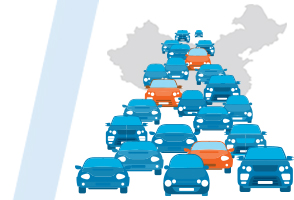
Top 3 Logistics Challenges for Automotive Manufacturers in China | Transportfolio
By 2020, China is expected to have more than 200 million registered vehicles [1]. And that’s only a tiny fraction of the country’s total population—there’s still plenty of room for growth. That’s not to say there aren’t challenges you’ll need to overcome as an automotive manufacturer in China—especially when it comes to logistics.
Billions of people and millions of square miles
At 1.4 billion people, China has the highest population in the world by a large margin. It makes sense that they’re also one of the largest countries in the world geographically—the fourth largest to be exact.
As part of China’s efforts to improve rural infrastructure, the government offers many incentives for automotive manufacturers to move operations to rural provinces. While lucrative, the incentives don’t always make up for the challenges you might face when operating in these outer provinces.
The sheer amount of land to traverse—approximately 3.7 million square miles—combined with less infrastructure than popular port cities, can make transportation significantly more difficult and costly.
Without many modal options—rail and water transportation are available, but don’t have the ability to support large amounts of freight at this time—road transportation is often the only choice. In fact, more than 80% of China’s inland freight is moved over the road [2].
Inland service providers can’t see everything
In the same way you’ll find In-N-Out Burgers all across the West Coast in the United States, but hardly at all in the rest of the country, you won’t find many logistics providers that serve both Tier 1 coastal cities and interior China.
Those that do often have disparate levels of service offerings. A wide portfolio of services available in the city may not be as extensive in a neighboring area. On the other side, providers in inland China have the relationships to move your goods; but they often lose visibility once freight is out of their primary area.
You can imagine how this becomes especially problematic when shipping globally and across multiple forms of transportation.
Differing regulations are hard to navigate
National requirements and municipal regulations may differ greatly. The national government is taking steps to make regulations less bureaucratic and cumbersome, but until this is complete, you may face inefficiencies and added expenses.
From a technical perspective, the Chinese government has already readily opened key databases so that logistics providers and manufacturers can share information and expedite customs processes. This is only one small change in the right direction. Over time, similar regulatory inefficiencies should also be resolved.
Overcoming top challenges
As you develop your automotive business in China, is your internal expertise up to the challenge? If you find your knowledge is too limited, the right global logistics provider can help.
[1] “Will the Chinese Car Population Peak with Regulatory Caps?,” Ministry of Industry and Information Technology, January 5, 2016.
[2] Pilar Dieter, “‘Go West’ into China…carefully,” DC Velocity, April 13, 2011.



